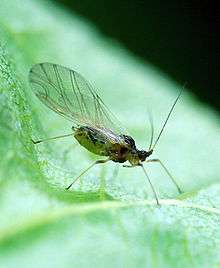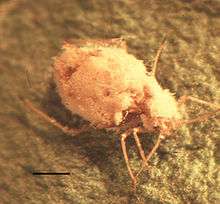Myzus persicae
Myzus persicae, known as the green peach aphid, greenfly, or the peach-potato aphid, is a small green aphid. It is the most significant aphid pest of peach trees, causing decreased growth, shrivelling of the leaves and the death of various tissues. It is also acts as a vector for the transport of plant viruses such as cucumber mosaic virus (CMV), potato virus Y (PVY) and tobacco etch virus (TEV). Potato virus Y and potato leafroll virus can be passed to members of the nightshade/potato family (Solanaceae), and various mosaic viruses to many other food crops.[2]
| Myzus persicae | |
|---|---|
 | |
| Scientific classification | |
| Kingdom: | Animalia |
| Phylum: | Arthropoda |
| Class: | Insecta |
| Order: | Hemiptera |
| Suborder: | Sternorrhyncha |
| Family: | Aphididae |
| Genus: | Myzus |
| Species: | M. persicae |
| Binomial name | |
| Myzus persicae | |

Originally described by Swiss entomologist Johann Heinrich Sulzer in 1776, its specific name is derived from the Latin genitive persicae "of the peach".[3]
Life cycle
The life cycle of green peach aphid varies considerably, and largely depends on winter temperatures. The green peach aphid can complete a generation with 10 to 12 days. More than 10 generations can occur in a year and even can be as much as 30-40 generation in a favourable climate. In the early spring, overwintering eggs hatch, and nymphs cause damage by feeding on buds, flowers, young foliage as well as stems. The worst damage is in the early summer time for the aphid breeding peak, because winged dispersants from Prunus spp where the egg of overwintering aphid stage deposit nymphs on summer hosts migrating to tobacco, potatoes and cruciferous vegetables to be harmful continuously after a few generations.[4]
Distribution
The green peach aphid is found worldwide, but is less tolerant of colder climates. It overwinters as an eggs, laid in trees of the genus Prunus. The aphid can benefit from the presence of greenhouses in these areas.[2]
Description
Adult green peach aphids appear in the summer, and are 1.8 to 2.1 mm long; the head and thorax are black, and the abdomen yellow-green with a dark patch on the back. The nymphs are at first greenish, then yellowish in colour; those that become winged females may be pinkish. Wingless adults resemble nymphs and are 1.7 to 2.0 mm long.[2]
The green peach aphid can be yellowish-green, red, or brown in colour because of morphological difference influenced primarily by the host plants, nutrition and temperature.[5]
In the warmer months, and throughout the year in warmer climates, the green peach aphid reproduces asexually; adults produce nymphs on a wide variety of herbaceous plant material, including many vegetable crops such as cabbage and its Brassica relatives, potato and other crops of the family Solanaceae, celery, mustard, pepper, pumpkin, okra, corn, and sunflower and other flower crops. Herbaceous weeds, such as white goosefoot (Chenopodium album) and common tumble weed (Amaranthus retroflexus) in the United States, also act as hosts. An individual can reproduce 12 days after being born and up to 20 generations may occur over the course of a year in warmer areas. As the weather cools, aphids mate and lay their tiny (0.6 mm x 0.3 mm) oval eggs in crevices of the bark of Prunus trees.[2]
The green peach aphid is an agricultural pest across the United States and worldwide,[2] including Australia.[6] Although insecticides are used to control it,[2] it develops resistance.[7][8] Many of its natural enemies can be used as biological control agents in certain crops, such as ladybirds (Coccinellidae) in radish crops, and the wasp Diaeretiella rapae in broccoli.[2]
Protecting and taking advantages of natural enemies can control and prevent the number of the green peach aphid by creating the favourable environmental condition which is beneficial for the development of natural enemies such as lady beetles (Coleoptera: Coccinellidae), flower flies (Diptera: Syrphidae), lacewings (Neuroptera: mainly Chrysopidae), parasitic wasps (Hymenoptera: Braconidae).Among the natural enemies of the M. persicae are both predators and parasitoids, including: beetles such as the Coccinellidae, including the two-spotted ladybird (Adalia bipunctata), seven-spotted ladybird (Coccinella septempunctata), and ten-spotted ladybird (Adalia decempunctata), true bugs such as the anthocorids or pirate bugs of the genera Orius and Anthocoris; neuropterans such as green lacewings of the genera Chrysopa and Chrysoperla, hoverflies such as Syrphus, Scaeva, Episyrphus, gall midges such as Aphidolestes, aphid parasitoids such as Aphidius,[9] and parasitic wasps of the family Braconidae.[2] They are also colonised and killed by the insect pathogenic fungi of the order Entomophthorales.[2]
Pest impact
The presence of the green peach aphid can be detrimental to the quality of the crops. In significant numbers it causes water stress, wilt, and reduce the growth rate of the plant. Prolonged aphid infestation can cause appreciable reduction in yield of root crops and foliage crops.
The green peach aphid transmits a number of destructive viruses in pepper including pepper potyviruses and cucumber mosaic cucumovirus,which causes plants to turn yellow and the leaves to curl downward and inward from the edges.[10]
Green peach aphid can harm more than 400 species of plants in more than 50 families. By sucking plant sap, it can lose the nutrients of crops and inhibit their growth and development. Its excreta (honey dew) accumulates on the leaves of crops, encouraging mould growth and affecting their growth and quality. The economic loss can be significant.. The aphid is also a major vector for the transport of plant viruses. It is known to be capable of transmitting 78 different plant viruses.
Control methods
Physical and mechanical control
We can utilize the preference for yellow the green peach aphids have to coat with oil or other viscous agents to kill them in the crop protection, from the ground height of 30mm evenly set yellow plate. One useful control measure is to take advantage of the negative taxis the green peach aphid has; hanging silver grey film or using silver grey film nets to cover field crops can inhibit their landing and settlement. Adults can be trapped by taking advantage of their preference for sweet or sour materials. Thus, a 20:2:1 solution of water, vinegar and brown sugar can be used to trap and kill them.[11]
Farming practices
Farmers usually fight against the green peach aphid by taking efficacious cultural practice. Adjusting the planting layout; adjusting the sowing time and harvest time; deep ploughing and winter turning over; appropriate use of crop fertilisers, and timely drainage and irrigation can all be used to minimise impact.
Biological control
The application of plant secondary substance is also playing a pivotal role in the population control since people increasingly put a premium on the environmental protection and sustainable agriculture.
Insect growth regulators like diflubenzuron, chlorbenzuron, and botanical pesticides like nicotine,azadirachtin also make the difference in the ecological management to reduce the number of the green peach aphid and damage pest caused. Similarly, the application of artificial insect pheromone or pest induction signal compounds in the field to control pests and attract natural enemies has obtained effective results, E-β-farnesene EβF the aphid alarm pheromone can interfere with aphid location and feeding, and also attract a variety of aphid natural enemies to control aphid population.[12]
Chemical control
It is commonly believed that cypermethrin, abamectin, chlorpyrifos, methylamine and imidacloprid could be the first chemical agents for aphid control in the field. Although imidacloprid is a good insecticide for the control of pests who have piercing-sucking mouthparts, frequent reuse may lead to the severe resistance of pests.[13]
References
| Wikimedia Commons has media related to Myzus persicae. |
- "Myzus persicae". Integrated Taxonomic Information System.
- Capinera, John L. (October 2005). "Featured creatures". University of Florida website - Department of Entomology and Nematology. University of Florida. Retrieved 2009-09-07.
- Simpson, D.P. (1979). Cassell's Latin Dictionary (5 ed.). London: Cassell Ltd. ISBN 0-304-52257-0.
- Van Emden HF, Eastop VF, Hughes RD, Way MJ. 1969. The ecology of Myzus persicae. Annual Review of Entomology 14: 197-270.
- Wang, Maotao et al. 1991 Study on the calorific biotypes of green peach aphid Acta Phytophylacica Sinica 18(4) : 351-353
- Berlandier, Françoise. "Aphid Pest Species of Potatoes in Western Australia". Horticulture Australia Limited. Retrieved 2009-09-09.
- "Insecticide Resistance in Myzus Persicae (Sulzer) (Hemiptera: Aphidid…". Archived from the original on 2013-01-05.
- "Myzus Persicae (Sulzer): Strains Resistant to Demeton-Smethyl and Dim…". Archived from the original on 2013-01-05.
- Response of Aphidius matricariae haliday (Hym.: Aphidiidae) from mummified Myzus persicae Sulzer (Hom : Aphididae) to short term cold storage
- Manoussopoulos, I. N. (2001). "Acquisition and Retention of Potato virus Y Helper Component in the Transmission of Potato aucuba mosaic virus by Aphids". Journal of Phytopathology. 149 (2): 103–106. doi:10.1046/j.1439-0434.2001.00580.x. ISSN 1439-0434.
- Dixon A.F.G 1988 Aphid ecology: an optimization approach. Second edition, UK: Chapman &Hall
- Cui L, Francis F, Heuskin S, Lognay G, Liu Y, Dong J, Chen J, Song X, Liu Y. 2012. The functional significance of E-beta-Farnesene: Does it influence the populations of aphid natural enemies in the fields? Biological Control, 60: 108-110.
- Cho J R, Ho ng K J, Yoo J K , et al1997. Comparative toxicity of selected insecticides to Aphis citricola, Myzus malisuctus ( Homoptera: Aphididae ), and the predator Harmornia axyridis ( Coleoptera: Coccinellidae) Journal of Economic Entomology, 90( 1): 11-15.